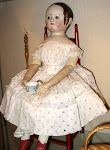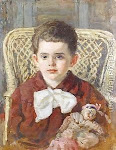
The story of four Imperial sisters from the dynasty of the Romanovs, though often re-told not only by historians, but also in movies, musicals and books, is not very well known to many people.

Olga and Tatiana.


No wonder - they are indeed just a tiny little piece of the great tapestry, which is history, but still - they lived, they breathed and walked this earth, they admired the beauty of the sunrise and of shimmering snow, they cried and laughed and loved.

"Anastasia"


Jumeau doll in the dress that fully copies garment of Russian Empress of 1772.

Olga Nicholovna, Grand Duchess of Russia, 1895-1918
Tatiana Nicholovna, Grand Duchess of Russia, 1897-1918
Marie Nicholovna, Grand Duchess of Russia, 1899-1918
Anastasia Nicholovna, Grand Duchess of Russia, 1901-1918
*************************************************************
Four daughters of Nikolai II., the last Tsar of Russia, vanished from history almost without a trace. Only after more than seventy years secret archives gave in the priceless documents: Their diaries, letters and photo albums with thousands of pictures. Some of those made its way out and they became nothing less but a window to the vanished past and the way of life of Imperial children.

The doll furniture for princesses was producing mainly in St. Petersburg. Nouveau magasin Etranger, Supplier of Imperial Court, Bolshaya Konyashinnaya 2, St. Petersburg.


Jumeau doll owned by Russian Princess. 1880s

Museum of Moscow early 19th century.

During the visit of Romanov’s family to Paris in 1896, French president presented to princess Olga a fabulousdoll with full trousseau: Including dresses, lingerie, hats, shoes and even dresser set .
*************************************************************
The last Russian Tsar, Nikolai II brought up respect to Russian history in his children, and even their dolls were serving to this purposes, for they were all dressed in the traditional Russian garments. In the Tsar’s collections were kept several antique dolls in traditional attire, as well as doll dresses of other nations of Russian Empire, as Tartar, Osetin or Ukranian.


These ceremonial dresses were made for the eldest daughters to wear for the 300th anniversary of the House of Romanov. The Empress had a tradition to dress the elder pair of daughters alike, and the younger pair alike. Tatiana's costume comes from the Alexander Palace and has the mark "T.N:" embroidered on the waist in pink silk, indicating that this dress belonged to Grand Duchess Tatiana Nicholaevna.Ceremonial Court Costumes of Grand Duchess Tatiana Nicholaievna & Grand Duchess Olga Nicholaievna.

The Romanov children were born into a life of immense luxury. Their father was undoubtably one of the most powerful monarchs in Europe, and their mother, the beautiful Tsarina, was a granddaughter of Queen Victoria of England. And yet, none of them were totally spoiled. Nicholas and Alexandra brought them up to be polite, well behaved, kind hearted individuals, who could do things for themselves instead of relying on servants.

Steiner Empress Doll
In the end of XIX – beginning of XX century importers brought to Russia a lot of French and German dolls, as Russia practically didn’t produced dolls this time. Children in Csar’s family were brought up in austerity, and every doll was a dear guest in nursery.

Russian Dolls from St.Petersburg early 19th century.
Every morning, the children would begin their day with a cold bath. They slept on hard camp beds with firm pillows. All four grand duchesses shared a room together. Their servants addressed them in simple Russian fashion, as in Olga Nicholaievna, Alexsei Nicholaievna. They asked politely for what they wanted, and they cleaned their own rooms, and made their own beds.

Nicholas and Alexandra had five children, four girls, and one boy, the heir to the Russian Throne. The girls, Olga, Tatiana, Marie and Anastasia all carried the title of Grand Duchess, which was a higher rank than that of a princess. Alexsei was the Tsarevich. Few siblings have been closer than the Romanov children.

Royal Romanov family and cossacks.

Haemophilia acquired the name “the royal disease” due to the high number of descendants of Queen Victoria afflicted by it.
Through two of the Queen's daughters, Alice, and Beatrice, both of whom were carriers, the disease was to be spread into many of the Royal Families of Europe.

Prince and Princesses

"Alexsei"

The disease was spread to the Romanov dynasty through the marriage of Alice's fourth daughter Alix, to Tsar Nicholas II. Alix, produced four daughters before giving birth to their only son, the Tsarevitch Alexis (11), heir to the Russian empire, who was also stricken with haemophilia. As with most mother's of haemophiliacs, Alix was overprotective of her son and worried about him constantly.

Nicky and Alexsei

Alexsei in his playroom.

"Rasputin"
Through his supposed ability to heal the infirm, the Tsar, and the Tsarina desperate, seeked the monk /healer Rasputin, and entrusted him with the child’s care. Rasputin was somehow able to bring the child back to health, and as a result of the unprecedented recovery of the dying Tzarevich, Nicolas and Alexis laid their complete confidence in Rasputin, not only on matters of health, but on matters of state. Rasputin became the decisive influence in the government, advising Alexandra on the conduct of internal affairs.

This made Russians lose faith in their Tzar. Unrest erupted in towns and villages up and down the country, adding hatred to their distrust of the regime. Rasputin acquired influence over the Tsar's decisions proved fatal, and led directly to the Russian Revolution.

The entire family perished at the hands of a Bolshevik firing squad in a cellar at Ekaterinberg on 17th July, 1918.

“Death cannot shatter love, what love unites no fate can separate, love will one day unite all the loving ones”





















































.jpg)












































































































